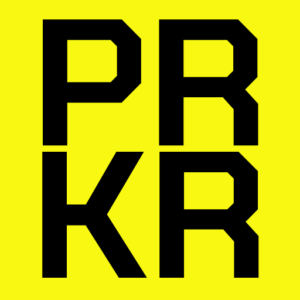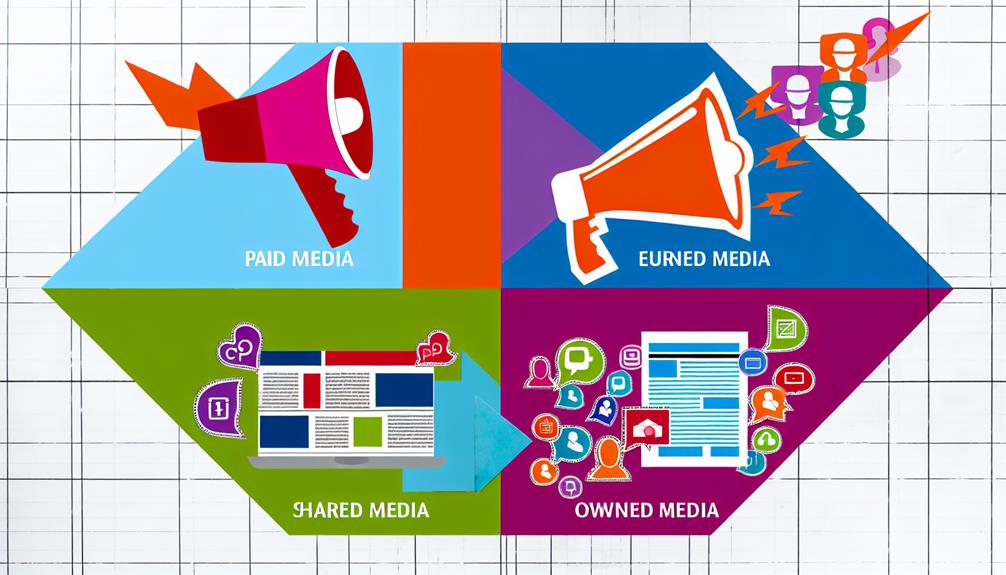The PESO model interlinks Paid, Earned, Shared, and Owned media, creating a comprehensive marketing strategy that boosts your brand’s reach and credibility. Paid media, like ads on social platforms, fuels traffic to your owned content. Earned media relies on positive PR and customer feedback, establishing trust. Shared media amplifies your messages through social engagement, while Owned media gives you control over your brand narrative. By integrating these elements, you maximize audience engagement and loyalty. Discover how each type contributes uniquely to your marketing success and forms a synergistic approach that adapts to evolving consumer behaviors.
Understanding the PESO Model
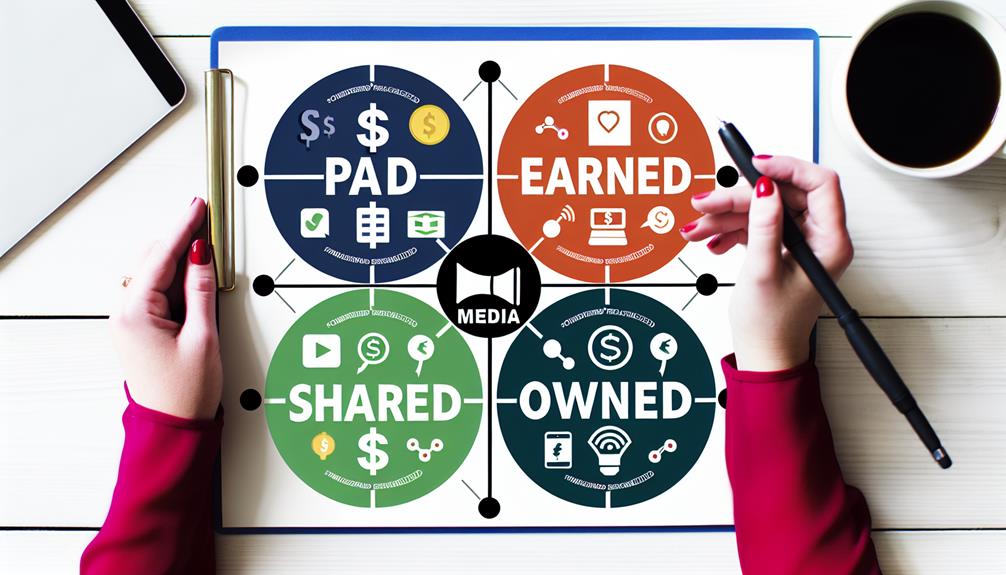
The PESO Model combines Paid, Earned, Shared, and Owned media to create a cohesive marketing strategy that benefits your brand.
Understanding how each component works together is crucial for maximizing your reach and engagement.
What is the PESO Model?
Understanding the PESO Model reveals a strategic framework that integrates four distinct media types—Paid, Earned, Shared, and Owned—into cohesive marketing communications. This model, coined by Gini Dietrich in her book Spin Sucks, emphasizes the importance of a holistic approach in media marketing.
Paid media refers to any content or exposure you purchase, such as paid social media ads or sponsored posts. In contrast, earned media strategies focus on gaining publicity through media relations and organic endorsements from influencers.
Your owned media strategy involves creating and controlling content, such as blogs or podcasts, which serve as the foundation for your overall marketing efforts. This approach enables you to establish authority and engage your audience effectively.
By integrating these four types, the PESO Model promotes a seamless content strategy that enhances brand visibility and credibility.
Additionally, this model encourages companies to invest in paid campaigns that can amplify earned and shared media outcomes. As you implement this media model, remember that the synergy of these components can significantly boost your marketing results and customer engagement.
The Importance of an Integrated Media Strategy
Combining paid, earned, shared, and owned media is essential for maximizing your brand’s reach, engagement, and credibility. An integrated media strategy allows you to leverage the strengths of each media type, creating a cohesive approach that enhances media exposure.
By using paid media strategies, you can amplify your owned content and drive traffic to your owned channels, such as your website and social media profiles. This synergy not only improves your chances of gaining earned media opportunities but also establishes you as a thought leader in your industry.
When your content is consistently shared across various platforms, it leads to increased media coverage and organic engagement. In today’s dynamic media landscape, understanding how to navigate each media type is crucial.
Social media marketing plays a pivotal role in this integration, as it allows for immediate interaction and feedback from your audience. By ensuring your messaging is consistent and aligned across all channels, you can effectively capture audience attention and foster long-term relationships.
Ultimately, an integrated media strategy enhances your brand’s authority and credibility, making it more resilient in a competitive market.
Paid Media

Paid media plays a crucial role in boosting your brand’s visibility and targeting specific audiences effectively.
You can explore various types of paid media, from digital ads to sponsored content, each offering unique advantages.
Understanding how to measure the success of your paid campaigns will help you optimize your strategies for better results.
Types of Paid Media
Advertising today comes in various forms, each tailored to reach specific audiences effectively. One major type is paid social, which encompasses social media advertising across platforms like Facebook and Instagram. These ads blend seamlessly with organic content, allowing you to engage users more naturally.
Another key form is paid search. This involves placing ads on search engines, targeting users based on relevant keywords to capture attention at critical moments.
Similarly, media placements in digital publications can increase visibility for your brand without relying solely on organic reach.
Sponsored content is also essential. This longer-form content provides value while promoting your brand, often appearing on reputable sites to foster trust among potential customers.
Additionally, influencer partnerships leverage the reach of social media influencers, allowing you to tap into their established audiences for authentic engagement.
All these different media types require a well-planned media budget to maximize their impact.
Measuring the Success of Paid Media
Effectiveness is crucial when determining the impact of your paid media efforts. In 2024, you need to measure key metrics to gauge success accurately. Understanding these elements helps you optimize your strategy and ensure you’re investing in paid media wisely.
Here’s a quick breakdown of vital metrics:
| Metric | Description |
|---|---|
| ROI | Measures the return on your investment in paid media. |
| Conversion Rates | Indicates the percentage of users who take desired actions. |
| Click-Through Rates | Shows the ratio of users who click on your ads versus those who see them. |
| Engagement Rates | Reflects how users interact with your content across platforms. |
Tracking ROI helps you determine if you’re getting sufficient returns from your campaigns. Conversion rates reveal how effectively your ads drive user actions, while click-through rates indicate the appeal of your messaging. By closely monitoring these metrics, you can adjust your marketing model to adapt to media changes and ensure your owned media is content that resonates with your audience. Remember, paid search can help enhance your visibility and ultimately lead to better performance in all media strategies.
Earned Media

Earned media is all about gaining visibility through third-party endorsements, and it can significantly boost your brand’s reputation.
By focusing on high-quality content and engaging with influencers, you can generate organic mentions that resonate with your audience.
Let’s explore how you can create earned media opportunities and understand its impact on your brand’s credibility.
How to Generate Earned Media
Generating earned media often hinges on strategic public relations efforts and authentic influencer engagement. To effectively generate earned media, consider these key strategies:
| Strategies | Description |
|---|---|
| PR Services | Utilize PR services to craft compelling press releases that highlight your brand’s unique story. Press releases are owned media that can attract media outlets. |
| Influencer Engagement | Collaborate with influencers who align with your brand values; their authentic endorsements can amplify your reach. |
| Customer Reviews | Encourage satisfied customers to leave positive reviews on social media platforms, enhancing your credibility. |
| Organic Social Media | Share valuable content on your owned media channels to attract attention. Engaging posts can lead to earned and shared media. |
| Engagement with Media Outlets | Actively pitch story angles to relevant media outlets, increasing your chances of coverage and backlinks. |
The Impact of Earned Media on Brand Reputation
Positive media coverage and organic endorsements can significantly enhance your brand’s reputation and credibility. When your brand earns media attention—whether through favorable press mentions, influencer reviews, or positive customer testimonials—this earned content acts as powerful social proof. It’s a key player in the PR and marketing landscape, driving word of mouth and elevating your brand’s standing among consumers.
In today’s digital age, different types of media, particularly social media posts and shared content, amplify the reach of earned media. For instance, when customers share their positive experiences online, it creates a ripple effect that can attract new audiences. This organic buzz often translates to higher trust levels than paid channels, as people tend to trust recommendations from peers over advertisements.
Utilizing the PESO model is a great strategy for integrating earned media with owned content, ensuring consistency and maximizing impact. Quality earned media not only strengthens brand reputation but also enhances visibility, making it an essential component of your overall marketing strategy.
Shared Media

When you think about shared media, social media plays a huge role in amplifying your message. By engaging with your audience on platforms like Facebook and Instagram, you can encourage conversations and shares that extend your reach.
Don’t overlook dark social, too; those private shares can significantly impact your brand’s visibility and influence.
Leveraging Social Media for Shared Media
To effectively leverage social media for shared media, brands must focus on creating engaging and shareable content that resonates with their audience. This involves understanding the unique features of different social media platforms and tailoring content accordingly. Here are a few strategies to encourage users to share your posts:
| Strategy | Description |
|---|---|
| Create Valuable Content | Produce content that provides real value, such as tips, infographics, or entertaining videos. |
| Incorporate Visuals | Use eye-catching images or videos in your social posts to grab attention and increase shareability. |
| Encourage Interaction | Ask questions or prompt discussions to engage users, making them feel part of your brand story. |
Utilizing the PESO model can enhance your marketing and PR efforts by integrating paid media to boost visibility and drive traffic to your owned media. By crafting shareable content, you not only enhance your brand’s reach but also increase the potential for earned media through organic shares. Remember, successful shared media campaigns depend on creating content that users want to spread across their networks.
The Role of Dark Social in Shared Media
Often overlooked, dark social refers to the sharing of content through private channels like messaging apps and email, where traditional tracking methods struggle to capture engagement. This hidden space impacts how you optimize shared media efforts. When users share your media via these channels, you miss out on valuable data that could enhance your strategies.
Incorporating dark social into your marketing approach requires you to acknowledge that media is content shared in different ways. While you may actively promote your owned and paid media across social media, you also need to encourage sharing in these less-visible channels.
Use earned media effectively by creating shareable content that resonates with your audience, motivating them to pass it along through private messaging.
To better understand the impact of dark social, monitor referral traffic and analyze patterns in user behavior. By recognizing where your audience engages with your content, you can adapt your strategy.
Owned Media

Owned media is your brand’s digital home, where you control the narrative and engage directly with your audience.
To build a strong owned media strategy, you’ll want to focus on creating valuable content that drives lead generation and showcases your expertise.
Building a Strong Owned Media Strategy
In today’s digital landscape, building a strong owned media strategy is crucial for establishing your brand’s voice and engaging your audience effectively.
To start with owned media, focus on creating high-quality content that resonates with your target audience. This media comes from assets like blogs, websites, and email newsletters, which you fully control.
Begin by clearly defining your goals for each piece of content, whether it’s driving traffic, generating leads, or increasing brand awareness.
Incorporate various content types—like eBooks, podcasts, and infographics—to cater to different preferences.
Also, ensure your content is optimized for search engines to drive organic traffic.
Social media can act as a complementary tool in your strategy; while using paid promotions on these platforms can amplify your reach, ensure that your owned media remains the foundation of your messaging.
Optimizing Owned Media for Lead Generation
Attracting and nurturing leads through owned media requires a strategic approach to content creation and optimization. Start by defining clear objectives for each piece of content, whether it’s driving leads or increasing brand awareness. Create valuable resources like blogs, eBooks, and webinars that address your audience’s pain points and showcase your expertise.
Next, focus on SEO to enhance visibility. Use relevant keywords, optimize meta tags, and structure your content for easy readability. Incorporate visuals like images, infographics, and videos to keep your audience engaged and improve retention rates.
Don’t forget to promote your owned media. Share your content on social media platforms and through newsletters to extend its reach. Encourage engagement by asking questions and inviting comments, creating a two-way conversation that nurtures leads.
Lastly, analyze your performance metrics. Track engagement, conversion rates, and traffic sources to understand what resonates with your audience. This data will inform future content strategies, ensuring you continuously optimize your owned media for lead generation.
Integrating PESO Model for Maximum Impact
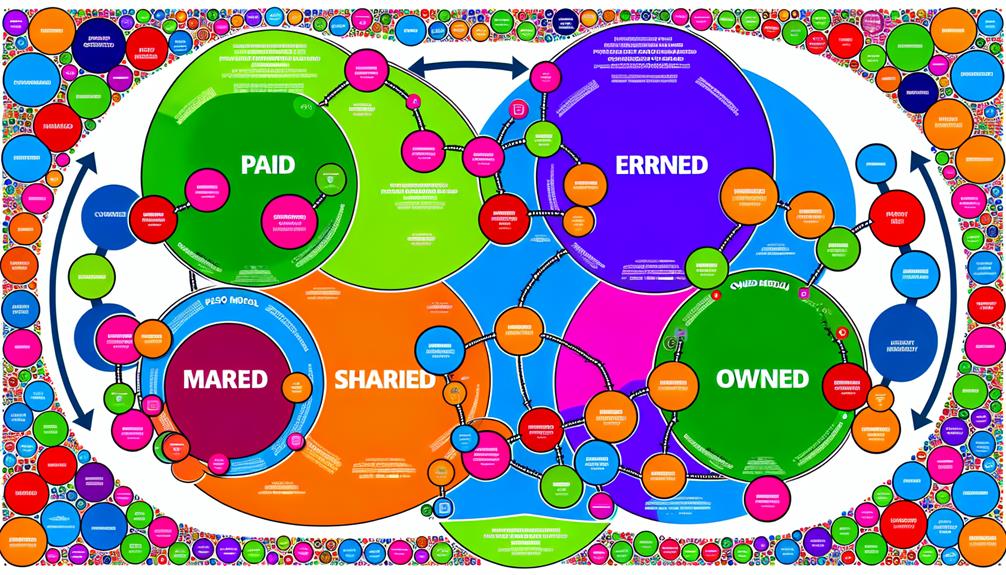
To maximize your marketing efforts, integrating the PESO model is essential.
You’ll want to explore case studies that showcase successful PESO integration and identify the right tools and metrics to track your effectiveness.
Case Studies of Successful PESO Integration
Successful PESO integration can transform a brand’s marketing strategy, driving engagement and boosting visibility across multiple channels.
One standout example is Starbucks, which effectively combines owned, earned, paid, and shared media. They utilize their blog and social platforms to share engaging content that resonates with their audience while running targeted paid ads to promote seasonal drinks.
This strategy not only fosters brand loyalty but also generates substantial earned media through customer conversations online.
Another compelling case is GoPro, which leverages user-generated content as part of their shared media strategy. By encouraging customers to share their adventures, GoPro creates a community around its brand while simultaneously using paid ads to showcase the best user content.
This approach amplifies their reach and drives engagement.
Tools and Metrics for Tracking PESO Effectiveness
Tracking the effectiveness of an integrated PESO strategy requires the right tools and metrics to ensure all media types work together seamlessly. You’ll want to harness analytics platforms that provide insights into how each media type interacts and contributes to your overall goals. Here are some essential tools and metrics to consider:
| Tool | Purpose | Metrics to Track |
|---|---|---|
| Google Analytics | Website visitor data | Traffic sources, bounce rates |
| Hootsuite | Social media management | Engagement rates, shares |
| SEMrush | SEO and keyword analysis | Keyword rankings, backlinks |
| HubSpot | CRM and marketing automation | Lead generation, conversion rates |
The Future of Media in Marketing

As the marketing landscape evolves, the PESO model adapts to harness emerging technologies and shifting consumer behaviors.
You’ll see brands increasingly leveraging artificial intelligence and machine learning to analyze consumer data, allowing for more personalized marketing strategies. This data-driven approach helps you understand your audience better and create targeted campaigns that resonate with them.
Moreover, the rise of voice search and smart devices is changing how consumers interact with brands. You’ll need to optimize your owned media for voice search queries, ensuring your content remains accessible.
As social media continues to dominate, shared media will play a pivotal role in fostering community engagement and facilitating organic conversations around your brand.
Additionally, the importance of earned media will grow as consumers seek authenticity and trustworthiness. Brands that cultivate genuine relationships with influencers and encourage organic reviews will gain significant advantages.
Ultimately, the future of the PESO model lies in its ability to integrate these trends seamlessly, creating a cohesive strategy that aligns with evolving consumer expectations.
Embracing this transformation will empower you to thrive in a competitive marketing environment.
Conclusion
By mastering the PESO Model, you can elevate your marketing strategy and effectively integrate Paid, Earned, Shared, and Owned media. Each type plays a unique role, helping you amplify your brand’s message and engage your audience. Embrace these media types to create a cohesive approach that not only enhances visibility and credibility but also fosters community and establishes your narrative. As you adapt to the evolving landscape, remember that a well-rounded strategy leads to measurable success and lasting impact.
